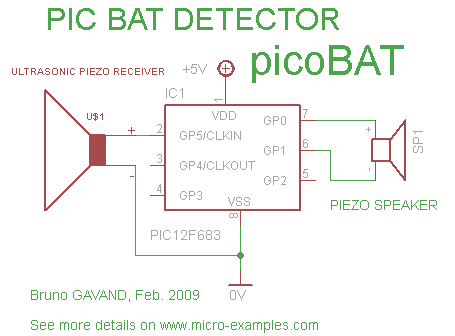Views
Views
From www.micro-examples.com
(Difference between revisions)
(→PicoBat : a PIC-based simple and cheap ultrasonic detector) |
(→Circuit Schematic) |
||
| Line 12: | Line 12: | ||
==Circuit Schematic== | ==Circuit Schematic== | ||
| − | [[File: | + | [[File:PicoBat-circuit-schematic.png]] |
| − | * | + | * The ultrasonic piezo receiver replaces resistor in PIC oscillator circuit |
| − | * | + | * SP1 is any piezo speaker you have |
==C Source code== | ==C Source code== | ||
Revision as of 18:55, 7 February 2012
An ultrasonic bat detector with only 3 components !
Contents |
PicoBat : a PIC-based simple and cheap ultrasonic detector
Let me introduce PicoBat to you with this short video clip :
The idea of this circuit is to hack PIC oscillator circuit, by replacing the crystal by a piezo sensor : the frequency of the oscillator will depend on presence ultrasonic waves.
Oscillator frequency is then divided and pushed to a piezo speaker.
It shares the same idea as PicoDetector, the metal detector.
Circuit Schematic
- The ultrasonic piezo receiver replaces resistor in PIC oscillator circuit
- SP1 is any piezo speaker you have
C Source code
/*
*******************************************************************************
* picoDetector : an ultra simple and cheap metal detector
*******************************************************************************
*
* Author : Bruno Gavand, april 2009
* see more details on http://www.micro-examples.com/
*
* source code for mikroC PRO compiler V1.65
* feel free to use this code at your own risks
*
* target : PIC12, oscillator in HS mode, watchdog enabled
*
* PIC PIN Assignemnt :
*
* GP0 : detect LED indicator
* GP1 : calibrate LED indicator
* GP2 : NC
* GP3 : NC
* GP4, GP5 : inductor
*
*******************************************************************************
*/
#define MAXTRY 15 // number of watchdog restart to calibrate loop counter
unsigned char ctr ; // number of loops between two watchdog resets
unsigned char previous ; // previous value of ctr
unsigned char calibr ; // calibration value when oscillator runs free
unsigned char restarts ; // number of watchdog restarts
unsigned char en ; // enable flag, allows detection
/*
* main loop
*/
void main()
{
unsigned char i ;
/*
* configure GPIO as digital port
*/
CMCON0 = 7 ;
ANSEL = 0 ;
TRISIO = 0 ;
GPIO = 0 ;
/*
* power up ?
*/
if(STATUS.NOT_TO)
{
/*
* yes, init variables
*/
restarts = 0 ;
calibr = 1 ;
}
/*
* watchdog reset counter
*/
if(restarts < 255) restarts++ ;
/*
* if counter differs too much from calibration value
*/
if((previous ^ ctr) > calibr)
{
/*
* turn detect LED on
*/
GPIO.F0 = en ;
/*
* if not on power up
*/
if(STATUS.NOT_TO == 0)
{
/*
* while in calibration mode
*/
if(restarts < MAXTRY)
{
/*
* shift calibration value
* and wait a little bit
*/
calibr <<= 1 ;
Delay_ms(5) ;
}
}
else
{
/*
* turn detect LED off
*/
GPIO.F0 = 0 ;
}
}
/*
* save last counter
*/
previous = ctr ;
/*
* is calibration over ?
*/
if(restarts > MAXTRY)
{
/*
* yes, turn calibrate LED off
* and set enable flag
*/
GPIO.F1 = 0 ;
en = 1 ;
}
else
{
/*
* no, turn calibrate LED on
* and clear enable flag
*/
GPIO.F1 = 1 ;
en = 0 ;
}
/*
* set watchdog prescaler
*/
OPTION_REG = 0b11111001 ;
/*
* start counter, to be interrupted by watchdog
*/
ctr = 0 ;
for(;;)
{
ctr++ ;
}
}
Download project
Download picoDetector_project.ZIP file for mikroC : File:PicoDetector-project.zip
Includes :
- mikroC PRO project files for PIC12F683, should work also with most of PIC
- picoDetector C source code
- picoDetector .HEX files
